Description
The NB-MIO-16L-9, manufactured by National Instruments, is a Multifunction I/O Board that is designed to interface with Macintosh NuBus computers, providing high-performance with its built-in 16-bit ADC and two 12-bit DACs. This board is part of the NB Series and supports RTSI bus for timing signal transfers between compatible NI boards.
With 16 analog inputs, which can be configured as 8 differential inputs, and a maximum data acquisition speed of 100 kS/sec, this board is highly versatile for various data logging and analysis tasks. Additionally, two voltage analog output channels are included for applications such as signal generation or control.
The NB-MIO-16L-9 also features 8 digital I/O terminals that are TTL-compatible, and it is equipped with three 16-bit timers/counters for precision counting and timing operations. For expanded capabilities, it supports the use of the AMUX-64T analog multiplexer for additional analog input channels, enhancing its adaptability for complex applications.
| Specification | Details |
|---|---|
| Part Number | NB-MIO-16L-9 |
| Manufacturer | National Instruments |
| Product Type | Multifunction I/O Board |
| Compatibility | Macintosh NuBus Computers |
| ADC Resolution | 16-bit |
| DAC Resolution | Two 12-bit |
| RTSI Bus Support | Yes |
| Series | NB Series |
| Analog Inputs | 16 (Configurable for 8 differential inputs) |
| Maximum Data Acquisition Speed | 100 kS/sec |
| Analog Output Channels | 2 voltage channels |
| Digital I/O Terminals | 8 TTL-compatible |
| Timers/Counters | 3 with 16-bit resolution |
| Additional Analog Input Support | AMUX-64T Analog Multiplexer (optional) |
Q1: What is the maximum data acquisition speed of the NB-MIO-16L-9 manufactured by National Instruments, and how does it enhance its functionality for complex applications?
A1: The AMUX-64T analog multiplexer enhances the NB-MIO-16L-9 Multifunction I/O Board by expanding its capability to handle additional analog input channels, thus allowing for more complex applications and a greater number of sensors or signals to be connected and processed by the board.
Q2: What is the function of the AMUX-64T analog multiplexer in relation to the NB-MIO-16L-9 Multifunction I/O Board?
A2: The NB-MIO-16L-9 Multifunction I/O Board has a maximum data acquisition speed of 100 kS/sec, and its compatibility with the AMUX-64T analog multiplexer enhances its functionality by allowing for the expansion of analog input channels, thereby accommodating more complex applications requiring additional data logging capabilities.
Q3: What are the key features and capabilities of the National Instruments NB-MIO-16L-9 Multifunction I/O Board in terms of analog and digital inputs, data acquisition speed, and expansion options?
A3: The National Instruments NB-MIO-16L-9 Multifunction I/O Board features 16 analog inputs configurable as 8 differential inputs, a data acquisition speed of up to 100 kS/sec, two 12-bit DACs for analog output, 8 TTL-compatible digital I/O terminals, three 16-bit timers/counters, and supports the RTSI bus and AMUX-64T analog multiplexer for expanded capabilities.
Q4: What is the maximum acquisition speed of the NB-MIO-16L-9 Multifunction I/O Board, and how does its compatibility with the AMUX-64T analog multiplexer enhance its functionality?
A4: The maximum data acquisition speed of the NB-MIO-16L-9 manufactured by National Instruments is 100 kS/sec, and its functionality for complex applications is enhanced by supporting the AMUX-64T analog multiplexer, which allows for additional analog input channels.
Q5: What are the features and capabilities of the National Instruments NB-MIO-16L-9 Multifunction I/O Board that make it suitable for data logging and analysis tasks in Macintosh NuBus computer environments?
A5: The National Instruments NB-MIO-16L-9 Multifunction I/O Board is suitable for data logging and analysis tasks in Macintosh NuBus computer environments due to its 16-bit ADC, two 12-bit DACs, compatibility with the RTSI bus for inter-board communication, 16 analog inputs configurable as 8 differential inputs, a data acquisition speed of up to 100 kS/sec, two analog output channels for signal generation or control, TTL-compatible 8 digital I/O terminals




